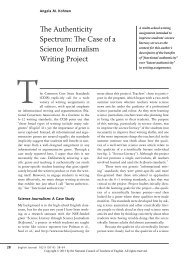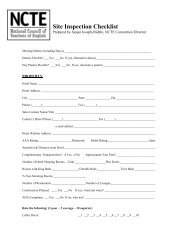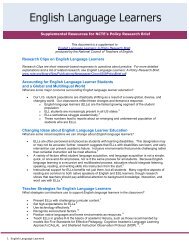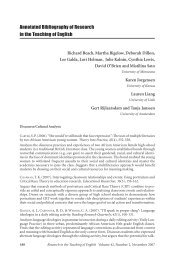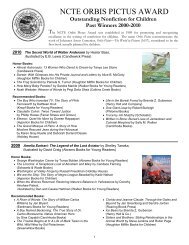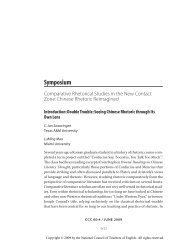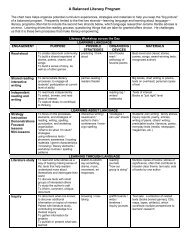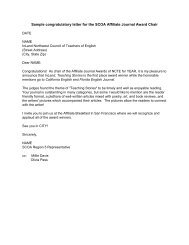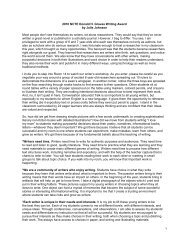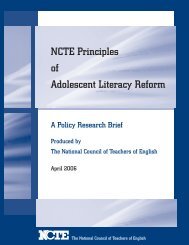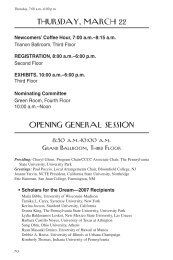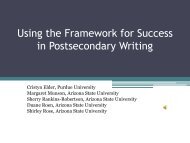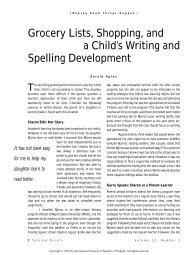Annotated Bibliography of Research in the Teaching of English
Annotated Bibliography of Research in the Teaching of English
Annotated Bibliography of Research in the Teaching of English
- No tags were found...
You also want an ePaper? Increase the reach of your titles
YUMPU automatically turns print PDFs into web optimized ePapers that Google loves.
228 <strong>Research</strong> <strong>in</strong> <strong>the</strong> Teach<strong>in</strong>g <strong>of</strong> <strong>English</strong> Volume 41 November 2006SPALDING, E., & WILSON, A. H. (2006). Bowl<strong>in</strong>g toge<strong>the</strong>r: Cultivat<strong>in</strong>g communities <strong>of</strong> practice <strong>in</strong><strong>English</strong> and social studies teacher education. <strong>English</strong> Education, 38(2), 102-122.THOMPSON, C. S. (2005). Powerful pedagogy: Learn<strong>in</strong>g from and about teach<strong>in</strong>g <strong>in</strong> an elementaryliteracy course. Teach<strong>in</strong>g and Teacher Education, 22(2), 194-204.VANHULLE, S. (2005). How future teachers develop pr<strong>of</strong>essional knowledge through reflectivewrit<strong>in</strong>g <strong>in</strong> a dialogical frame. L1-Educational Studies <strong>in</strong> Language and Literature, 5(3), 287-314.WALLACE, F. H. (2006). Under pressure: Controll<strong>in</strong>g factors faced by classroom literacy teachersas <strong>the</strong>y work through a pr<strong>of</strong>essional development program. Read<strong>in</strong>g Horizons, 46(3), 143-165.WHITIN, P. (2006). Forg<strong>in</strong>g pedagogical paths to multiple ways <strong>of</strong> know<strong>in</strong>g. <strong>English</strong> Education,38(2), 123-145.Second Language LiteracyBIALYSTOK, E., & MCBRIDE-CHANG, C. (2005). Bil<strong>in</strong>gualism, language pr<strong>of</strong>iciency, and learn<strong>in</strong>g toread <strong>in</strong> two writ<strong>in</strong>g systems. Journal <strong>of</strong> Educational Psychology, 97(4), 580-590.Compares <strong>the</strong> development <strong>of</strong> phonological awareness and word decod<strong>in</strong>g <strong>in</strong> <strong>English</strong> and Ch<strong>in</strong>esefor 204 five- and six-year-olds who were monol<strong>in</strong>gual <strong>English</strong>-, bil<strong>in</strong>gual <strong>English</strong>-Ch<strong>in</strong>ese-,or Ch<strong>in</strong>ese-speak<strong>in</strong>g. F<strong>in</strong>ds that <strong>the</strong> three groups demonstrated different progress <strong>in</strong> <strong>the</strong>irearly literacy and phonological awareness acquisition. Because <strong>of</strong> differences <strong>in</strong> <strong>the</strong> two writ<strong>in</strong>gsystems and <strong>the</strong> specific strategies needed to decode words <strong>in</strong> each, bil<strong>in</strong>gualism per se did not<strong>in</strong>fluence overall decod<strong>in</strong>g results. Ra<strong>the</strong>r, children’s level <strong>of</strong> pr<strong>of</strong>iciency <strong>in</strong> each language, <strong>the</strong>irprogress <strong>in</strong> literacy development, and <strong>the</strong> relation between <strong>the</strong> two writ<strong>in</strong>g systems were most<strong>in</strong>fluential. Stresses <strong>the</strong> importance <strong>of</strong> consider<strong>in</strong>g all <strong>the</strong>se factors <strong>in</strong> research exam<strong>in</strong><strong>in</strong>g howchildren become literate <strong>in</strong> two languages.CALLAHAN, R. M. (2005). Track<strong>in</strong>g and high school <strong>English</strong> learners: Limit<strong>in</strong>g opportunity tolearn. American Educational <strong>Research</strong> Journal, 42(2), 305-328.Investigates <strong>the</strong> <strong>the</strong>oretical and practical tensions with<strong>in</strong> and among <strong>English</strong> fluency and content-areaacademics for <strong>English</strong> language learners. Subjects are representative <strong>of</strong> California’shigh school cohorts, consider<strong>in</strong>g both residency and school<strong>in</strong>g prior to immigration (n=355).F<strong>in</strong>ds that <strong>the</strong> complexity <strong>of</strong> learn<strong>in</strong>g <strong>English</strong> and academic success are also reflections <strong>of</strong> studentopportunity and teacher expectations to ga<strong>in</strong> and demonstrate competency <strong>in</strong> contentareas. Invites all stakeholders to look at academic rigor across <strong>English</strong> language models andlonger-term access to education beyond high school.CAREÉN, G. P., DRAKE, C., & CALABRESE-BARTON, A. (2005). The importance <strong>of</strong> presence: Immigrantparents’ school engagement experiences. American Educational <strong>Research</strong> Journal 42(3),465-498.Engages work<strong>in</strong>g-class immigrant parents <strong>in</strong> conversations and written narratives about <strong>the</strong>irengagement <strong>in</strong> <strong>the</strong> educational lives <strong>of</strong> <strong>the</strong>ir children. Discusses practices and structures fordialogues that describe participation <strong>in</strong>side and outside <strong>the</strong> classroom. Claims process-oriented<strong>in</strong>teractions <strong>in</strong> particular spaces, us<strong>in</strong>g specific forms <strong>of</strong> capital, creates parental engagementthat benefit children’s school experiences.DWORIN, J. E. (2006). The family stories project: Us<strong>in</strong>g funds <strong>of</strong> knowledge for writ<strong>in</strong>g. TheRead<strong>in</strong>g Teacher, 59(6), 510-520.Describes a literacy project designed to encourage students’ <strong>in</strong>-class use <strong>of</strong> both Spanish and<strong>English</strong> through collect<strong>in</strong>g and translat<strong>in</strong>g family stories. The program built on 4th grade Lat<strong>in</strong>ostudents’ funds <strong>of</strong> knowledge by focus<strong>in</strong>g on <strong>the</strong>ir languages and families as key cultural resources.Provides examples <strong>of</strong> how students collected family stories, wrote <strong>the</strong>m down and



